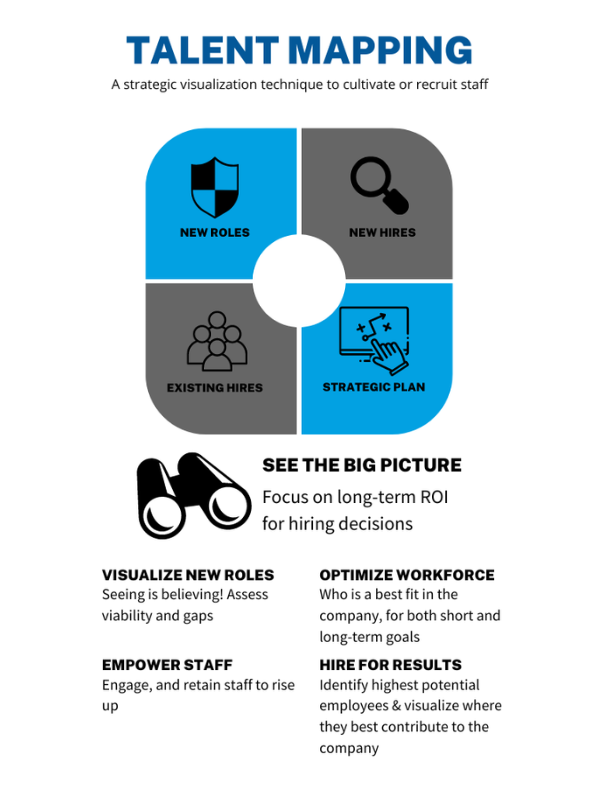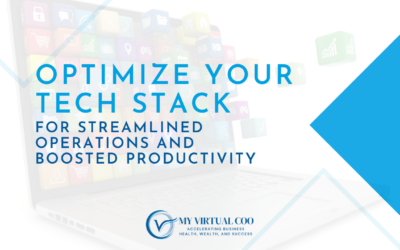When was the last time you thought about cultivating new hires into employees that your business will need tomorrow?
How often do current employees crave a vision of their future? Or executives wondering what is next for them as they nurture the younger generation of staff?
Most business owners have thought about where they’d like their business to go in the future, but with very little thought as to (1) the viability of current staff, (2) gaps in current and future staffing arrangements, or (3) new hires needed to reach the next level of their business gracefully and enjoyably.
After more than thirty years transforming businesses, I know that visualizing career paths and hiring needs (aka. talent mapping) is the most effective and powerful way to accomplish all three of these goals and scale the business with less effort and cost.
The Psychological Advantages of Seeing the Big Picture
There are profound psychological benefits to seeing your people from a bird’s eye view. After all, “seeing is believing”, right? And thanks to the bestselling self-help novel, The Secret, manifesting your future desire is now a mainstream idea, albeit overused at times.
What isn’t overused is the power of a talent map that imagines the roles you will need filled as your business grows or a responsibilities chart showing now and the future, after business improvements (aka changes) are implemented.
Psychologically speaking, visualizing helps prepare the mind for change before it happens so you can more calmly think about change. This method conditions your brain to see, hear, and feel the final outcome. That’s why talent and responsibilities mapping, for current employees, new hires, and providers, is essential to proactively and wisely planning your next steps and getting buy-in.
“The greatest value of a picture is it forces us to notice what we never expected.” – John Wilder Tukey, founder of the fast Fourier Transform (FFT)
How to Talent Map to Visualize New Hires
Talent mapping begins with assessing the viability of your current staff and identifying the gaps that need to be filled immediately. In the process, you might find that you don’t necessarily need to hire, but simply rearrange staff to new roles.
Talent mapping also allows you to identify the highest potential employees on your team and visualize where you see them best contributing to your business in the future. This lets you know who to nurture into a higher role and who may not be a good fit long-term.
Don’t just limit your talent mapping to full-time staff. Be sure to include outsourced vendors and service providers into your talent map. Everyone from the CEO to the cleaning crew should be included.
Here is an easy implementable Talent Mapping template to get you started. And here is a sample of Responsibilities Mapping.

Visualizing New Hires (That Don’t Currently Exist)
One of the most common questions is how to visualize an organizational chart with people that don’t currently exist. How do we imagine filling a role we don’t have a need for yet? For example, you might not be big enough to need a marketing manager on your team just yet, but you will in the future. Maybe a coordinator on the current team will step up and fill that role, or perhaps you will need to hire or outsource. Talent Mapping or Role Charting shows the potential for top-talent to rise up, while also pinpointing where you are lacking the potential skillset right now.
Another example is the demand for expansion of one role as your company grows or shedding roles to others more suited for the responsibilities. Right now, you may have one person filling the role of administrator. As you expand your team and customer base, you will need a manager, coordinator, and possibly a third hire to handle the load that this one person currently fills. The talent map helps visualize how your needs will expand as the business expands.
The Main Goal (and Primary Benefit) of Talent Mapping
Overall, the goal of talent mapping through graphic visualization is to ensure that you have a strategic plan in place to cultivate or recruit the staff you need to achieve your short and long-term business objectives. Talent mapping also helps with succession planning for your future exit from the business. With a mindset primed for change and strong talent mapping tools at your disposal, if you can see it, you can achieve it.
If you are a service-based business looking to invest in the right activities today to make your future vision a reality, let’s chat. Schedule a call with us to go over the service option that would be best for you.
Interested in seeing where your business stands? Take our free 2-minute business assessment here.







